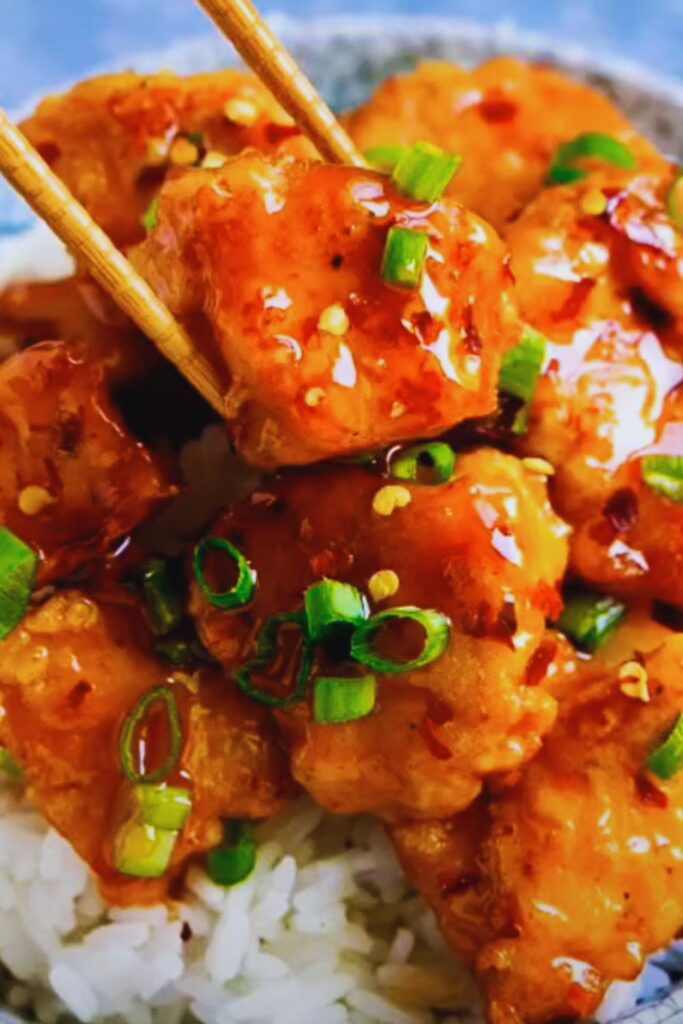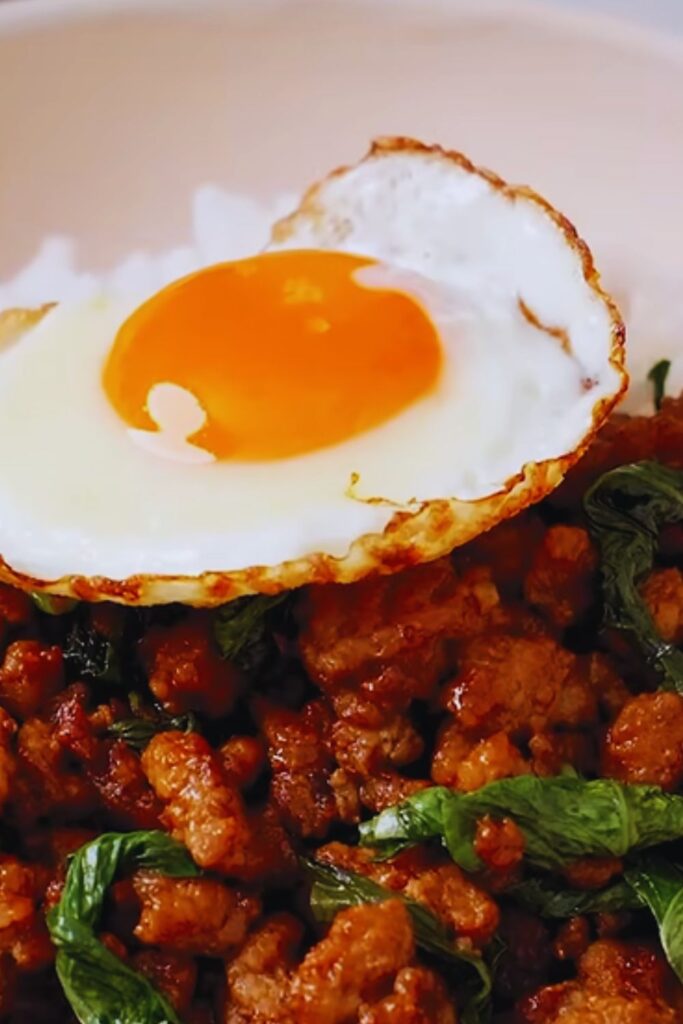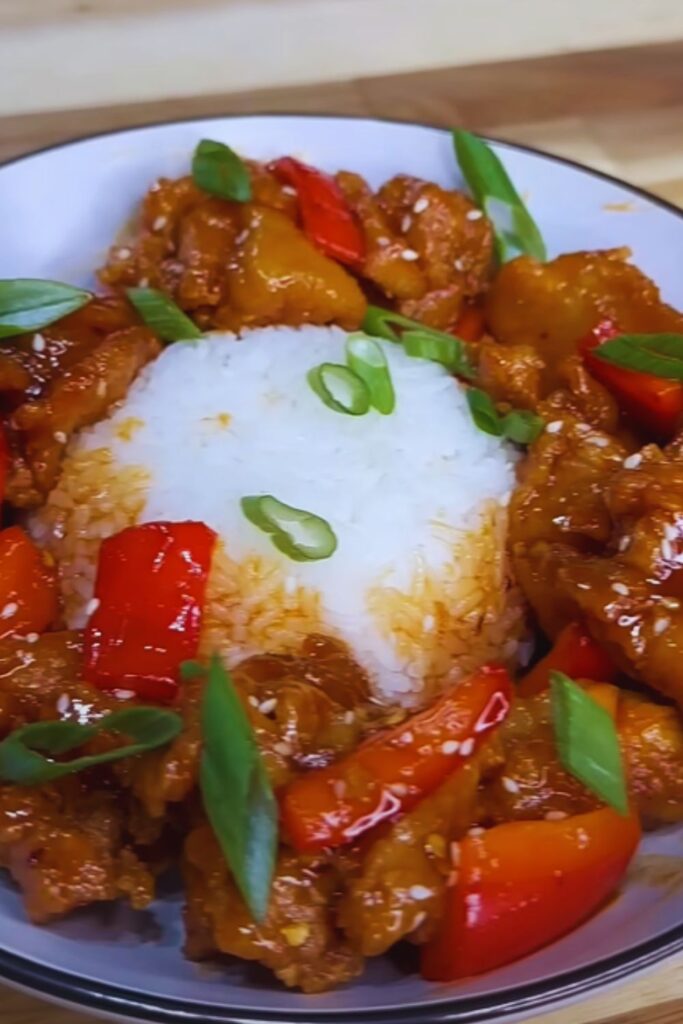There’s something incredibly satisfying about creating a meal that explodes with flavor in every bite. As someone who’s tested countless stir fry recipes in my kitchen, I can confidently say that Firecracker Chicken Stir Fry stands out as a magnificent crowd-pleaser that brings restaurant-quality tastes to your dining table. The combination of tender chicken pieces coated in a sweet, spicy, and sticky sauce alongside colorful vegetables creates a dish that’s not just delicious but also visually stunning.
What Makes Firecracker Chicken Special?
Firecracker Chicken gets its name from the bold, explosive flavors that characterize this dish. The sauce perfectly balances sweetness with heat, creating that addictive quality that keeps you coming back for “just one more bite.” I’ve spent years perfecting this recipe, adjusting ingredient proportions until finding that perfect harmony of flavors that makes taste buds dance.
Unlike many takeout versions that leave you feeling heavy and lethargic, my homemade Firecracker Chicken Stir Fry delivers all the satisfaction without the excessive oil or additives. It’s a healthier alternative that doesn’t sacrifice an ounce of flavor, and the best part? You can adjust the spice level to suit your personal preference.
The History Behind Firecracker Chicken
While not traditionally found in authentic Chinese cuisine, Firecracker Chicken is an American-Chinese fusion creation that has roots in Hunan and Szechuan cooking styles. These regional Chinese cuisines are known for their liberal use of chili peppers and spicy sauces, which inspired the development of this fiery dish.
The modern Firecracker Chicken we know today gained popularity in American Chinese restaurants in the 1990s and early 2000s as diners sought more exciting flavor experiences. I remember my first encounter with this dish at a small family-owned restaurant in San Francisco, where the chef explained he’d created his version after customers requested something “with a kick” that wasn’t the typical sweet and sour offering.
What makes this dish special is how it has evolved over time, with each chef adding their personal touch. My version incorporates elements from both traditional Chinese cooking techniques and modern flavor profiles that appeal to contemporary palates.
Essential Ingredients

The magic of Firecracker Chicken Stir Fry lies in its carefully selected ingredients. Here’s what you’ll need to create this spectacular dish:
For the Chicken Marinade:
- 1.5 pounds boneless, skinless chicken breasts or thighs, cut into 1-inch cubes
- 2 tablespoons cornstarch
- 1 teaspoon salt
- ½ teaspoon white pepper
- 1 tablespoon Shaoxing wine (or dry sherry)
For the Signature Firecracker Sauce:
- ⅓ cup buffalo sauce or hot sauce
- ⅓ cup brown sugar, packed
- 2 tablespoons rice vinegar
- 3 tablespoons soy sauce (low-sodium preferred)
- 1 tablespoon sesame oil
- 1 tablespoon cornstarch
- 2-3 tablespoons sriracha (adjust according to heat preference)
- 2 tablespoons honey
- 1 tablespoon minced garlic
- 1 tablespoon grated fresh ginger
For the Stir Fry:
- 3 tablespoons vegetable oil, divided
- 1 red bell pepper, sliced
- 1 yellow bell pepper, sliced
- 1 cup snow peas, strings removed
- 1 medium onion, sliced
- 4-6 dried red chilies (optional for extra heat)
- 4 green onions, sliced diagonally (whites and greens separated)
- 1 tablespoon toasted sesame seeds
The Perfect Protein Choice
While I typically use chicken for this recipe, the versatility of Firecracker sauce means you can create equally delicious variations:
| Protein Option | Cooking Time | Texture | Best Paired With | Notes |
|---|---|---|---|---|
| Chicken Breast | 6-8 minutes | Lean, tender when not overcooked | Bell peppers, snow peas | Slice against the grain for maximum tenderness |
| Chicken Thigh | 8-10 minutes | Juicier, more flavor | Heartier vegetables like broccoli | More forgiving if slightly overcooked |
| Shrimp | 2-3 minutes | Firm, succulent | Snap peas, water chestnuts | Remove tails for easier eating |
| Tofu (extra firm) | 5-6 minutes | Crispy exterior, soft interior | Bok choy, mushrooms | Press water out and coat with cornstarch before cooking |
| Beef Sirloin | 3-4 minutes for medium | Rich, satisfying | Onions, thick-cut carrots | Slice very thin against the grain |
Step-by-Step Cooking Instructions
Preparation Phase:
- Cut your chicken into uniform 1-inch cubes to ensure even cooking.
- In a medium bowl, combine chicken with marinade ingredients (cornstarch, salt, white pepper, and Shaoxing wine). Toss until evenly coated and let sit for at least 15 minutes.
- While the chicken marinates, prepare your vegetables by washing and cutting them into even-sized pieces.
- Mix all sauce ingredients in a bowl until well combined. The cornstarch might clump initially, but keep stirring until smooth.
Cooking Process:

- Heat 2 tablespoons of vegetable oil in a large wok or skillet over high heat until it just begins to smoke.
- Add marinated chicken in a single layer (work in batches if necessary to avoid overcrowding). Allow it to sear untouched for 1-2 minutes until golden brown on one side.
- Stir-fry for another 4-5 minutes until chicken is cooked through. Remove from the wok and set aside.
- Add remaining tablespoon of oil to the wok. When hot, add the white parts of green onions, dried chilies (if using), and stir for 30 seconds until fragrant.
- Add bell peppers and onions. Stir-fry for 2 minutes until vegetables begin to soften but remain crisp.
- Add snow peas and stir-fry for another minute.
- Return chicken to the wok and toss with vegetables.
- Give your sauce a quick stir (the cornstarch may have settled) and pour it into the wok.
- Stir continuously as the sauce begins to bubble and thicken, about 2-3 minutes.
- Once the sauce has thickened and coats everything nicely, remove from heat.
- Garnish with green parts of onions and toasted sesame seeds.
Common Mistakes and How to Avoid Them
Throughout my years of preparing this dish, I’ve noticed several pitfalls that can prevent you from achieving stir-fry perfection:
- Not having ingredients prepped beforehand: Stir-frying happens quickly. I always prepare and organize all ingredients before turning on the heat.
- Overcrowding the pan: This leads to steaming rather than searing. If necessary, cook in batches to maintain high heat and get that desirable caramelization.
- Using cold chicken straight from the refrigerator: Cold protein can cool down your wok too quickly. I allow my chicken to sit at room temperature for 15-20 minutes before cooking.
- Not patting chicken dry before marinating: Excess moisture prevents proper browning. Always pat your chicken dry with paper towels.
- Stirring constantly: While it’s called a stir-fry, allowing the chicken to sear undisturbed at first creates that beautiful caramelization.
- Using low heat: Stir-frying requires high heat to seal in flavors and maintain the vegetables’ crunch. My wok is always screaming hot before ingredients go in.
Variations to Try
One aspect I love about Firecracker Chicken is its adaptability. Here are some variations I’ve experimented with over the years:
Vegetable Variations:
- Colorful Crunch: Add water chestnuts, baby corn, and broccoli florets
- Umami Boost: Incorporate sliced mushrooms and bok choy
- Summer Harvest: Mix in zucchini, yellow squash, and cherry tomatoes (add tomatoes at the very end)
Sauce Adjustments:
- Citrus Twist: Add orange or pineapple juice and zest for a tangy variation
- Peanut Fusion: Stir in 2 tablespoons of peanut butter for a satay-inspired flavor
- Extra Garlicky: Double the garlic and add garlic chips as garnish
Serving Styles:
- Lettuce Cups: Serve in Boston or iceberg lettuce leaves for a low-carb option
- Noodle Bowl: Toss with cooked ramen or udon noodles
- Rice Alternative: Serve over cauliflower rice for a lighter meal
Nutritional Benefits
Beyond its incredible taste, Firecracker Chicken Stir Fry offers substantial nutritional benefits:
| Ingredient | Key Nutrients | Health Benefits |
|---|---|---|
| Chicken | Protein, B vitamins, selenium | Muscle building, immune support, metabolism |
| Bell Peppers | Vitamin C, A, potassium | Antioxidant protection, eye health, heart health |
| Snow Peas | Vitamin K, C, fiber | Bone health, immune support, digestive health |
| Ginger | Gingerol compounds | Anti-inflammatory, digestion aid, nausea relief |
| Garlic | Allicin compounds | Immune support, heart health, anti-inflammatory |
| Sesame Seeds | Calcium, iron, magnesium | Bone health, blood cell production, muscle function |
A typical serving provides approximately 380-420 calories, 35g protein, 25g carbohydrates, and 18g fat, making it a balanced meal option when paired with a small portion of brown rice or served on its own.
Serving Suggestions

To create a complete dining experience, I recommend these complementary sides:
- Steamed jasmine or brown rice: The perfect canvas to soak up that amazing sauce
- Simple cucumber salad: Thinly sliced cucumber, rice vinegar, and a touch of sugar for a cooling contrast
- Miso soup: A light starter that sets the stage for the bold main course
- Steamed edamame: A protein-rich appetizer sprinkled with sea salt
- Fresh fruit platter: End with refreshing fruits like watermelon, pineapple, or lychee to cool the palate
For special occasions, I often create a DIY Firecracker Chicken bar, where guests can customize their spice level and toppings. Options include extra sriracha, sliced fresh chilies, cooling cucumber, crispy fried shallots, and various herbs like Thai basil or cilantro.
Make-Ahead and Storage Tips
One of the reasons I turn to this recipe for busy weeknights is its excellent meal prep potential:
- Marinade prep: Chicken can be marinated up to 24 hours in advance, developing even more flavor
- Vegetable prep: Cut vegetables can be stored in airtight containers for up to 2 days
- Sauce preparation: The Firecracker sauce keeps well in the refrigerator for up to 5 days in a sealed container
- Leftovers: Store in airtight containers for up to 3 days in the refrigerator
- Freezing: While fresh is best, you can freeze the cooked dish for up to 1 month. Thaw overnight in the refrigerator and reheat in a skillet with a splash of water or chicken broth
For meal prep, I often make a double batch of sauce to use throughout the week on other proteins or roasted vegetables.
Perfect Pairings for Every Occasion
The right pairing can elevate your Firecracker Chicken Stir Fry from a delicious meal to an unforgettable dining experience:
- Casual family dinner: Serve with iced tea infused with lemon and mint
- Dinner party: Offer coconut water or a cucumber-ginger mocktail
- Lunch option: Pair with unsweetened green tea for a refreshing midday meal
- Kids’ favorite: Tone down the spice and serve with homemade lemonade
Frequently Asked Questions
Q: How can I adjust the spice level without losing flavor?
For milder versions, start by reducing the sriracha by half and omitting the dried chilies. Use a milder hot sauce as your base, and increase the honey by 1 tablespoon to balance the reduced heat. If you prefer extra spicy, add 1/2 teaspoon of crushed red pepper flakes or 1 finely diced fresh jalapeño with seeds to the stir-fry.
Q: Can I make this dish gluten-free?
Absolutely! Replace soy sauce with tamari or coconut aminos, and verify that your hot sauce is gluten-free (most are, but some contain additives with gluten). The cornstarch used for thickening is naturally gluten-free.
Q: What’s the best substitute for Shaoxing wine if I don’t have it?
Dry sherry works beautifully as a substitute. If you prefer non-alcoholic options, use chicken broth with a tiny splash of rice vinegar or white grape juice with a few drops of rice vinegar.
Q: Can I prepare this in advance for a party?
Yes! Cook the chicken and vegetables separately and refrigerate. Prepare the sauce but don’t combine it with the protein and vegetables. When ready to serve, quickly reheat the chicken and vegetables in a hot wok, add the sauce, and finish cooking until thickened. This approach prevents overcooking while still delivering fresh-made flavor.
Q: Why does my sauce sometimes turn out too thin?
The most common reason is not allowing the sauce to simmer long enough after adding it to the wok. Remember that cornstarch needs to come to a bubble and then cook for at least 1-2 minutes to reach full thickening power. Also, if your vegetables release a lot of water during cooking, this can dilute your sauce. Try cooking vegetables at a higher heat to evaporate moisture quickly.
Q: How do I prevent my chicken from becoming tough?
Three key factors: 1) Don’t skip the marinade, which tenderizes the meat, 2) Slice chicken against the grain, and 3) Be careful not to overcook. Remove the chicken from the wok while it’s just cooked through, then return it later to combine with the sauce.
Q: What’s the secret to restaurant-quality results at home?
Heat is crucial! Professional kitchens use extremely high heat, which is difficult to replicate at home. To compensate, preheat your wok or skillet thoroughly before adding ingredients, cook in smaller batches to maintain temperature, and keep ingredients moving constantly once added to the pan.
Chef’s Notes and Final Tips
After years of perfecting this recipe, I’ve discovered a few professional tricks that elevate this dish from good to spectacular:
- Velveting technique: For super tender chicken, after marinating but before stir-frying, briefly blanch the chicken in simmering water with a tablespoon of oil for 30 seconds, then drain well. This seals in moisture before the final cooking.
- Sauce consistency: The perfect Firecracker sauce should coat the back of a spoon but still flow slowly when tilted. If too thick, add water a teaspoon at a time; if too thin, mix a teaspoon of cornstarch with a tablespoon of cold water and stir in.
- Wok hei: To achieve that elusive “breath of the wok” flavor, once your dish is nearly finished, push everything to the sides of the wok, add a final tiny drizzle of oil to the center, and let it heat until smoking before quickly tossing everything together one last time.
- Balancing act: If your sauce tastes too sweet, add a few drops of rice vinegar; too salty, add a touch more honey; too spicy, incorporate a tablespoon of butter at the end of cooking to mellow the heat.
- Garnish with purpose: Beyond aesthetic appeal, garnishes add crucial final flavor notes. Try fried garlic chips, microgreens, or a last-minute drizzle of chili oil to add complexity.
I hope this Firecracker Chicken Stir Fry brings as much joy to your table as it has to mine over the years. Remember that cooking is both science and art—follow the guidelines, but don’t be afraid to adapt according to your taste preferences. The most important ingredient in any dish is the love and attention you put into preparing it!
Q&A Section
Q: I don’t have a wok. Can I still make Firecracker Chicken?
Yes, absolutely! While a wok provides ideal heat distribution for stir-frying, a large, heavy skillet works well too. Cast iron is particularly good because it retains heat beautifully. Just make sure whatever pan you use is preheated properly before adding ingredients, and you may need to cook in smaller batches to prevent overcrowding.
Q: Can I prepare the sauce in advance and store it?
Definitely! The Firecracker sauce keeps well in the refrigerator for up to 5 days in an airtight container. Just give it a good stir before using as the cornstarch might settle. Having pre-made sauce on hand makes weeknight cooking much faster.
Q: My family includes both spice lovers and those who prefer milder food. How can I accommodate everyone?
This is a common challenge in many households. I recommend preparing the base dish with medium heat, then serving additional sriracha or chili oil on the side for those who want extra kick. Alternatively, you can divide the sauce before adding the spicy elements, making a mild version and a spicy version, then cooking two separate batches.
Q: What’s the best way to prepare this for meal prep?
For meal prep, I suggest slightly undercooking the vegetables so they don’t become mushy when reheated. Store the cooked chicken, vegetables, and sauce separately if possible. When reheating, use a hot skillet rather than a microwave for best texture, adding a splash of water if needed to loosen the sauce.
Q: Is there a vegetarian version of this dish?
Absolutely! Extra-firm tofu works wonderfully with this sauce. Press the tofu for at least 30 minutes to remove excess moisture, then cut into cubes and toss with cornstarch before frying until golden. You could also use seitan, tempeh, or a mixture of hearty mushrooms like king oyster or portobello as your protein base.




